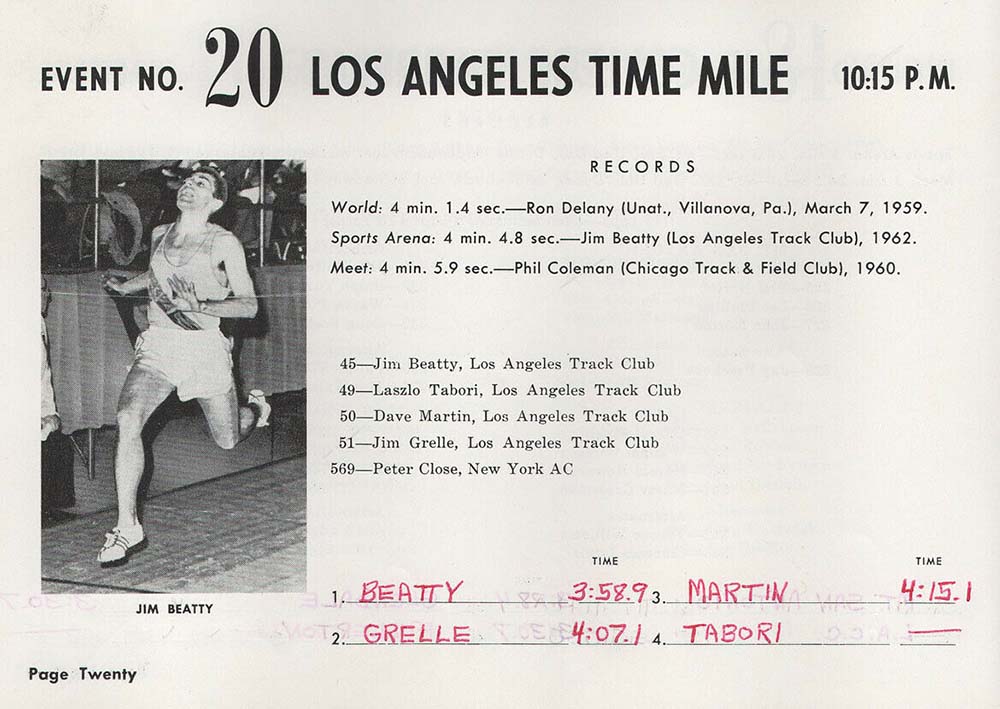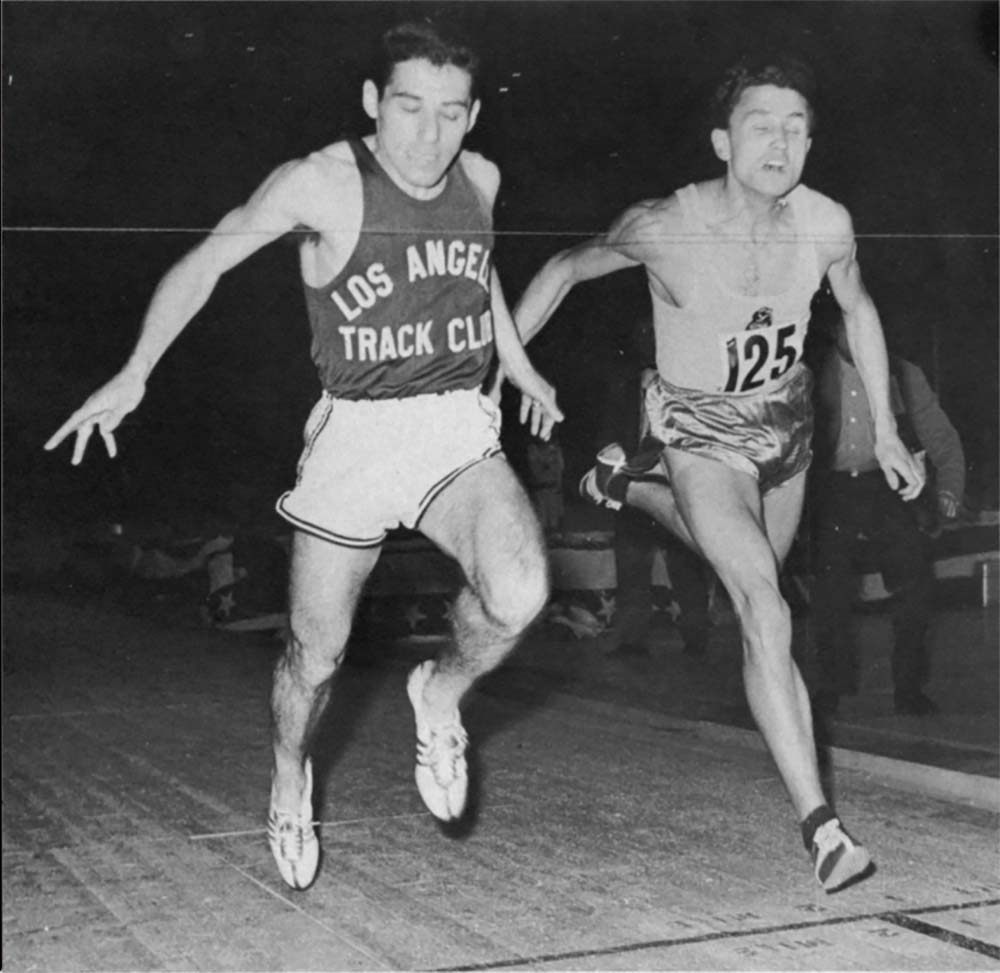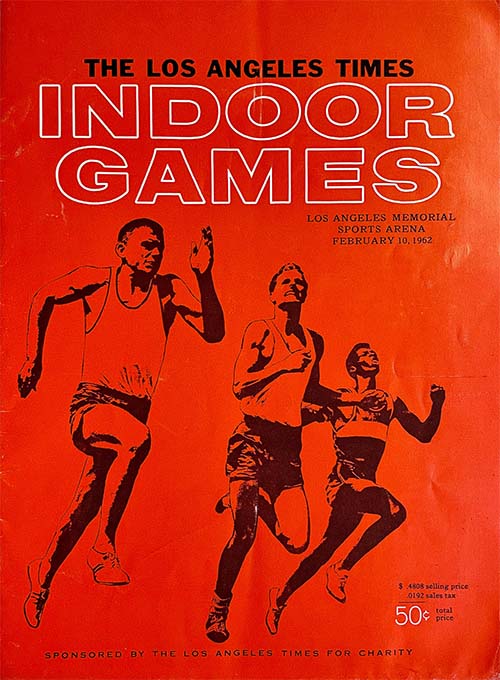
On the T&FN website on February 10, 60 years to the day after history’s first indoor sub-4:00 mile, we published the following account of Jim Beatty’s buildup to his historic run in Los Angeles. Correspondent Mike Fanelli mined the miler’s mind for fascinating firsthand memories.
AT THE COAXING OF A FRIEND, former UNC Tar Heel Jim Beatty road-tripped up to Philadelphia to witness the ’59 USA vs. USSR contest at Franklin Field. As per usual, said dual meet delivered epic high drama, with the American squad outlasting the Soviets 127–108.
What really stuck in young Jim’s craw was the strategically run metric mile by Dyrol Burleson and Jim Grelle who finished 1-2 with identical marks of 3:49.4. To which Beatty’s seatmate announced, “You could do that.”
Beatty, the NCAA 2M/5000 runner-up as a soph and junior, had run a 4:06.5 mile as a senior in ’56 but hadn’t run a step in nearly 2½ years. Two months passed since he’d been a spectator and a fan at that Cold War contest held in the City Of Brotherly Love before he finally got the nerve to ring up his old college mentor, Dale Ranson, to whom he posed two questions: “Do I still have what it takes to make the Olympic team, and if you think so, can I come up there to Chapel Hill and have you coach me?”
Ranson thoughtfully replied, “Jimmy, I always said that you could become a World Record setter, but if you decide to do it, I’d suggest you move to California and train with Coach Iglói. He can develop you to the best of your abilities.” Without any further ado, the 24 year-old Olympic aspirant loaded up his cherry red and white ’57 Chevy Bel Air and headed west.
Beatty was not unfamiliar with Mihály Iglói. After the Hungarian coach and his prized pupil László Tábori had defected from their war-torn country following the Melbourne Olympics, they found solace and a training facility on the North Carolina campus. Beatty had done a touch of training with them there and so, when he arrived in San José at the Santa Clara Valley Youth Village’s afternoon practice on November 01, was immediately welcomed by the notoriously stern taskmaster, Iglói.
Fast forward almost seven months to the day: Beatty, off a steady diet of twice-a-day interval training, 6 days a week, became the third American to run under 4:00. On May 28, 1960, at Modesto’s California Relays, he scratched out 3:58.0 for the win, while bettering Burleson’s 5-week-old American Record in the process.

Later in the year, injury kept Beatty from the Olympic 5000 final but the always plucky once-upon-a-time boxer rallied his way back to top form for the ’61 campaign. In fact, on the Euro circuit, he won nearly every race he contested that summer while improving his 1500 PR to an American Record 3:40.2.
Unfortunately, while in Warsaw, his season was curtailed when he slipped and seriously strained a buttock muscle. He tried to train and race through it to no avail, and so once again found himself on the injured reserve list.
As summer morphed into autumn, Beatty found himself rehabbing his latest ailment in Southern California. By this time, the SCVYV group had moved there and reinvented themselves as the Los Angeles TC. They trained at the Crenshaw District’s Dorsey High School, every morning at 7:00 a.m., one by one, they climbed the chain-link fence that surrounded the cinder oval. Always, Iglói was already inside and awaiting his troops.
One morning in mid-October, “a light bulb went off” in the mind of Beatty. It was as though a sudden inspiration had overwhelmed him. Said Aha! moment was when it had dawned on him that “the time had come for someone to run an indoor mile under 4:00.” Shortly thereafter, the mending miler went to Iglói with the bold pronouncement, “I want to be the first man to run 4:00 indoors.”
With the new season rapidly approaching, “I asked him if we still have time to reach the kind of peak conditioning that such a feat would require.”

Iglói closed his eyes, and when he reopened them, in his stilted English replied, “You have time.” He closed his eyes a second time. When he opened them back up he proclaimed, “We will run 4-minutes mile on February 10 at LA Times.”
Recalls Beatty, “It was astounding. Iglói was the only man who had training down to an equation. He could project the training that it would take and tell you what time you would run at a particular date in the future. I don’t know how he knew it.” And so the rigorous goal-driven training resumed in earnest.
The LA Memorial Sports Arena rested adjacent to the LA Coliseum. It was dedicated by then Vice President Richard Nixon on July 04, 1959. On this Saturday night in question, in excess of 13,000 paid ticketholders packed it to the rafters. They had come to witness the quite ballyhooed 3rd Annual LA Times Indoor Games featuring many of the sports biggest names across numerous disciplines. When ABC’s Wide World Of Sports caught wind of a mile World Record attempt, it too joined the fray.
The fireworks started with event number 11 on the docket, the 1000y, which began at 9:15 p.m. The ’60 Olympic gold medalist by way of New Zealand, Peter Snell, would run his first ever race on a small wooden track.
Leading from the gun, the muscular Kiwi middle-distance marvel hit 53.0 and 1:50.2. Much to the delight of the vocal crowd, Snell delivered the mail in the WR time of 2:06.0, slicing a hefty 1.9 seconds from the existing mark. Canadian ace Bill Crothers finished just a few ticks back in 2:07.4, also under the old best.
At precisely 9:25 p.m. the entrants in the 2M toed the line. Murray Halberg, the marquee entrant, like Snell hailed from New Zealand, and also was the reigning Olympic 5000 champion. Halberg employed Snell-like tactics in an attempt to eclipse his own World Record by leading from wire-to-wire and managed a landslide victory over Bob Schul by nearly 13 seconds. While shy of the world standard, Halberg’s 8:42.5 consolation prize was both a new meet and arena record.
Meanwhile, the men of the LATC jogged the auditorium’s corridors blissfully unaware of the pyrotechnics on the track. When asked later if the undercard competitions had aroused him, Beatty replied, “I had no idea about the other races, I was solely focused on what lay ahead… what it was that I had to do. I warmed up out of earshot and didn’t even enter the track venue until it was time to change into my spikes and do strides.”
Shortly after second call, in keeping with his typical methodology, Iglói gathered his navy-clad troops to talk strategy. Beatty recollects, “Coach Iglói got László Tábori, Jim Grelle and I together and laid out the meticulous plan and the times for each 440. Tábori would go first in 58 to 59 and I would take over and come in at 1:58 or 1:59 at the half. Then Jim [Grelle] would take us through the three-quarters in 2:58.”
Promptly at 10:15, the announcer introduced the field beginning with Tábori on the pole. Seven years earlier, Tábori had become just the third man in the world to run under 4:00 minutes outdoors. Immediately to his right, in order, were Beatty, Duck, Grelle, the LATC’s Dave Martin, plus St. John’s alum and 1500 Olympian Pete Close to round out the field.
While Les Heilman called the runners to their mark and raised his starter’s pistol high, Jim McKay told the TV watchers at home, “This one could really be something, because a 4-man team from The Los Angeles Track Club has announced it is going to make a kind of a group assault on the World Indoor Record.”
The gun sounded and before the smoke had cleared, the high cadence pounding sound of footfalls on echoey wood ensued.
Up in the stands, keenly interested spectators included coaching legend Arthur Lydiard with pupils Halberg and Snell, who quipped, “I’m glad I am not in that mile. I don’t think I’d fare so well against them on these boards.” Back on the track, the Hungarian expat Tábori performed his metronomic yeoman duties to perfection, splitting 59.1 at the quarter.
“I was right on his heels when my great teammate László immediately moved out to enable me through without having to go wide around him,” remembers Beatty. “And then it was my turn.”
Beatty urgently surged to the fore and his conscientious tempo carried him through his 2¾-lap assignment past the barking timer in a swift 1:59.6. The reluctant Jim I-never-take-the-lead-this-early Grelle was next up, and the race was on.
Meet announcer Dick Nash stoked the rabid fans’ flames into a near frenzy with his telling of the pace as it unfolded. After two more circuits, Beatty could just feel the tempo slowing down and so going into the eighth lap, slingshotted out of the turn earlier than anticipated in order to take the reins of his own destiny.
As Beatty took off, the full house began an ever-escalating roar. It was so deafening that it entirely silenced the lap timer’s bark.
“My mind was entirely alert. I told myself to listen for the 1320 mark so that I’d know how fast that I needed to run the last quartermile. When I could not hear it, I thought, ‘OK, listen again’ because I knew that there’d be a 5 second pause before the P.A. announcer gives the time to the crowd. Still, it was so raucous, I could not hear. From there, I ran out of complete fear.”
Running for his life, the mighty mite plowed away at full tilt, grinding towards the finish with every single stride. If you watch the vintage ABC coverage you’ll hear McKay excitedly declare, “Jim Beatty’s pouring it on. Watch him go. You may be seeing track history here and now.”
Dick Bank, who was calling the event along with McKay, breaks in and takes over the broadcast in the final seconds. “He’s going to make it, he’s going to make it!” an excited Bank shouts. “He’s going to run the first 4-minute mile!”
Head bobbing and weaving out of the final turn, Beatty sprints to the tape in an unprecedented 3:58.9 to become the first to achieve the coveted sub-4 mile indoors.
Beatty later recalled, “Ironically, I was probably the only individual in the LA Sports Arena who did not know whether I had broken 4 when I crossed the line.”
Beatty took a couple of short strides forward before making a decided U-turn back towards the white-tuxedoed finishline crew. “Did I make it?” he pleaded. “When I heard their ‘three…’ response, I knew I had broken the indoor 4-minute mile and immediately took off on multiple victory laps.”
Beatty’s first stop along the way was a ‘thank you’ bear hug with mastermind Iglói.
In celebration of Beatty’s magical mile moment, the afterparty spilled over to Sunshine, a downtown Hungarian restaurant where champagne and goulash intermixed quite seamlessly. There, the new recordholder confirmed, “I knew I was ready to run under 4:00. I think that I might have done 3:57 if we had done the three-quarters in 2:58 like Iglói wanted us to.”
The deserved revelry lasted well into the wee hours. “I didn’t get to bed until well past 2:30,” said the ordinarily disciplined athlete.
Upon reflecting to the author just prior to the 60th anniversary, when asked of its overall career significance, Beatty readily opined, “It was by far my crowning achievement. You can set a record time, but it will eventually be broken. Whereas being the very first to accomplish something special, well that can never be taken away… it is everlasting.”
And so it shall be into perpetuity with James Tully Beatty’s ‘Bannisteresque’ magnum opus, some six decades gone-by.
(If you are a T&FN Premium subscriber, don’t miss the full catalog of 1960s back issues [microfilm scans].)
